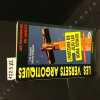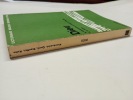-
Type
Art print (7)
Book (8441)
Magazine (12)
Maps (4)
-
Latest
Last 24h (4)
Last 3 days (2)
Last month (115)
Last week (9)
-
Language
Albanian (1)
Dutch (2)
English (1)
French (8438)
Greek (1)
Hebrew (3)
Italian (4)
Latin (5)
Portuguese (1)
Swedish (8)
-
Century
16th (26)
17th (82)
18th (157)
19th (874)
20th (4591)
21st (426)
-
Countries
Belgium (2478)
Canada (11)
Côte d'Ivoire (5)
Denmark (34)
France (5623)
Germany (1)
Greece (2)
Italy (13)
Netherlands (53)
Switzerland (244)
-
Syndicate
ALAC (11)
CLAM (6)
CLAQ (4)
ILAB (4726)
NVVA (146)
SLACES (146)
SLAM (4503)
SNCAO (2)
Dieu parmi les hommes, la bible et l'église au fil des siècles. La Vie Montante.
Paris, Editions Médialogue, 1984 12 x 20, 272 pp., broché, très bon état
LES ORIGINES, COMMENTAIRE SUR LES CINQ PREMIERS CHAPITRES DE LA GENESE
Librairie Victor Palmé, Paris. 1870. In-8. Broché. Etat d'usage, Couv. légèrement passée, Dos satisfaisant, Quelques rousseurs. 310 pages. Papier muet encollé sur le dos, le consolidant. Etiquette de code sur la couverture. Quelques tampons de bibliothèque.. . . . Classification Dewey : 220-Bible
Par Mgr de Kernaëret, Camérier secret de Sa Sainteté. Classification Dewey : 220-Bible
"Abrégé du Nouveau Testament; ouvrage accompagné d'un lexique grec-latin-français de tous les mots et de l'analyse des formes les plus difficile qui se rencontrent dans cet ouvrage."
Liège, Spée-Zelis, Libraire-Editeur, 1900. 11 x 18, 154 pp., reliure d'édition dos toilé, bon état.
Texte en grec.
Rechtfertigung bei Paulus. Studien zum Struktur und zum Bedeutungsgehalt des paulinischen Rechtfertigungsbegriffs
Münster, Verlag Aschendorff 1971 vii + 336pp., 2nd edition, hardcover (editor's cloth), 24cm., in the series "Neutestamentliche Abhandlungen. Neue Folge" vol.3, Good condition, R78505
Les Evangiles en argot. L'histoire de Juju les bons tuyaux (sa vie, son oeuvre). D'après les Evangiles de Mat, Lulu, Marco et Jeannot. Suivie du dictionnaire d'argot.
1989 Editions S.V.P, Paris - 1989 - In-8 broché, couverture illustrée - 191 pages - Illustrations en N&B, in et hors-texte, dans l'ouvrage
Très bon état - Infimes frottements sur le coin inférieur et les coiffes Très bon
Au pays des pierres saintes.
France, Presses de la Cité, 1958 13 x 21, 315 pp., cartonnage éditeur + jaquette, bon état
Egisei "Araracoc' meknowt'iwne" [= 'The Interpretation of the Genesis' by Elishe]
Yerevan [Erevan], Zvartnots 1992 320 + [8] pp., 21cm., text in Armenian (with a second title page in English), publisher's hardcover in blue cloth with gilt lettering, text is clean and bright, good condition, cfr. OCLC 773949932, X116776
Corpus Christianorum. Anastasius Sinaita Sermones duo in constitutionem hominis secundum imaginem Dei necnon opuscula adversus monotheletas,
Turnhout, Brepols, 1985 Hardback, CLXVII+202 p., + 1 table, 155 x 245 mm. ISBN 9782503401218.
Languages: Greek.
Corpus Christianorum. Anastasius Sinaita Viae dux,
Turnhout, Brepols, 1981 Hardback, CCXLVII+455 p., 155 x 245 mm. ISBN 9782503400815.
Languages: Greek.
Homiliae Pseudo-chrysostomicae Instrumentum studiorum I.,
Turnhout, Brepols, 1994 Paperback, 309 p., 153 x 245 mm. ISBN 9782503503400.
Die Erforschung der Pseudo-Chrysostomica hat seit 1968 mit den Codices Chrysostomici Graeci und mit der Ubersicht uber noch nicht editierte Texte, die M. Geerard 1974 im zweiten Band der Clavis Patrum Graecorum zusammengestellt hat, fur jene Patristiker, die an kritischen Editionen von Homilien arbeiten, grosse Fortschritte gemacht. Die Texte selbst sind aber bisher einem grosseren Kreis interessierter Patristiker nicht zuganglich geworden; wollte man auf kritische Editionen denselben warten, in denen die Uberlieferungsgeschichte anhand aller uns noch zuganglichen Zeugen geklart wird, dann besteht wenig Hoffnung, dass sie in kommenden Jahrzehnten jenen Patristikern und allgemein jenen Philologen bekannt werden, die nicht unmittelbar mit den betreffenden Handschriften selbst arbeiten. Die Clavis von M. Geerard nennt allein 239 nicht editierte Texte, und diese Liste ist bei weitem nicht vollstandig. Sucht man nach einem Weg, alle bekannten Pseudo-Chrysostomica so schnell wie moglich gedruckt vorlegen zu konnen und dennoch einen im allgemeienen vertraubaren Text zu schaffen, dann kan dies nur bedeuten, dass man in Ausgang von einer oder mehrerer "guter" Handschriften den Text ohne jeden Apparat und ohne irgendeinen Kompromiss in Richtung einer kritischen Edition wiedergibt. Die Texte, die Bernard de Montfaulcon (1655-1741) geschaffen hat, leisten uns noch heute nutzliche Dienste; und wer vor allem am Inhalt von Texten interessiert ist, wird deren Aussage im allgemeinen auch mit einem Migne-Text gut erfassen. Das wissenschaftliche Ideal einer kritischen Edition wird damit nicht in Frage gestellt, sicher nicht von den Herausgebern dieses neuen Instrumentum studiorum. Language : Greek.
Analysis Biblica seu universae scripturae sacrae - Analytica expositio ; Tomus I
, Lutetiae/Parisiorum, Impensis Julien - Lanier et Sociorum - Bibliopolarum, 1856, Vol.I (of two) ; XVI + 528pp. + XXXII pp.indices, Editio altera annotationibus aucta, modern cart.cover, 22cm., few stamps, foxing in text, text in Latin, R30435
Literarkritische und formgeschichtliche Untersuchung des Heiligkeitsgesetzes
Bonn, Peter Hanstein 1963 xvi + 186pp., 25cm., in the series "Bonner Biblische Beiträge" vol.19, softcover (some use), 2 stamps, G, R70156
Le dieu inconnu de la bible. Un mystère ufologique.
Coll. "Enigma", Agnières, éd. Le temps présent, 2010, in-8, cartonnage souple, couv. ill. coul. éd., 138 pp., sommaire, "Alors que les religions grecques, latines, égyptiennes, hindoues – entre beaucoup d'autres – nous ont livré des représentations de leurs divinités, celles du Livre recèlent un profond et irritant mystère : il n'existe aucune image théologiquement reconnue du dieu de la Bible. Y a-t-il une raison précise à ce vœu explicite de YHWH ? Pourquoi voulait-il cacher à tout prix son corps et son visage à tout le monde ? Seul Moïse avait pu le contempler sans problème. Que voulait-il dissimuler et qui ne devait être révélé à aucun prix ? Toutes ces questions trouveront une réponse dans le présent ouvrage avec une argumentation basée, aussi bien sur les écrits anciens et païens, les textes canoniques ou apocryphes, que sur des données scientifiques contemporaines. Un portrait réaliste, quoique singulier et hors du commun, pourra être ainsi dessiné du dieu fondateur des religions judéo-chrétiennes, tout au long des pages qui vont suivre. Des géants dont parlent les traditions antiques aux êtres reptiliens, l’auteur nous entraîne aux confins de la religion… et de l’ufologie". Pas courant Très bon état
Librairie spécialisée en gastronomie , œnologie et tabagie
Comment peut finir l'univers d'aprés la science et d'aprés la bible.
Paris, Bloud, collection "Science et religion, Etudes pour le temps présent", 1901, 1 br. in-12 de 61-(2) ;
Charles de Kirwan, fut inspecteur des Forêts à Gap.
Phone number : 06 80 15 77 01
Pseudo-Philo's Liber antiquitatum biblicarum
Notre Dame (Indiana), University of Notre Dame 1949 277pp. + frontispice + plates out-of-text, 23cm., in the series "Publications in Mediaeval Studies" vol.10, softcover, 3 stamps (of which a small one at lower edges), else G, (introduction in English, text in Latin), R70116
Bau der Gemeinde. Das paulinische Wortfeld oikodomê /(ep)oikodomein
Würzburg, Echter Verlag 1986 ix + 357pp., 24cm., in the series "Forschung zur Bibel" vol.53, softcover, 3 stamps (of which a small one at lower edges), else VG, R69982
Corpus Christianorum. Petrus Abaelardus Glossae super Peri hermeneias,
Turnhout, Brepols, 2004 Hardback, CVI+500 p., 155 x 245 mm. ISBN 9782503050690.
The commentary on Aristotle's Peri hermeneias is certainly one of the most important texts in the corpus of Peter Abaelard's works on logic. The author discusses the Aristotelian text in an unbiased and thorough manner without avoiding any difficulties, and thereby addresses all basic issues of classical logic and semantics. The text forms part of the so-called 'mixed commentaries' and is characterised by short self-contained systematic discussions within an explication of the Aristotelian text. Of particular significance are the discussions of predication (chapter 3), future contingentia (chapter 9) and modal logic (chapters 12-14). In 1927, this substantial commentary was edited by Bernhard Geyer. The edition was based on the only manuscript of the text then known to scholarship (Milan, Biblioteca Ambrosiana M 63 sup., fols. 45r-72r). In 1938, M. Grabmann discovered a second manuscript of the work (Berlin, Staatsbibliothek Preussischer Kulturbesitz, lat. fol 624, fols. 97r-146r). As L. Minio-Paluello has shown, the final part of Abaelard's text, which includes the long excursus on modal logic and the commentary on chapters 12-14, is accurately preserved only in this second manuscript. He edited this final part in 1958. A detailed comparison of the two manuscripts showed that the differences between them are so numerous and noteworthy that a new critical edition was necessary. Geyer's and Minio-Paluello's editions could be improved upon in several places. Aristotle's text in the version known by Abaelard is also included. Unter den logischen Schriften des Peter Abaelard ist der Kommentar zu Aristoteles Schrift Peri hermeneias sicherlich eine der wichtigsten. Unbefangen, grundlich, keinem Problem ausweichend, diskutiert Abaelard den Aristotelischen Text ? und das heisst: alle prinzipiellen Fragen der klassichen Logik und Semantik. Der Text gehort zu den sog. 'gemischten Kommentaren' und zeichnet sich durch geschlossene kleine systematische Abhandlungen innerhalb der Erorterungen des aristotelischen Textes aus. Zu erwahnen ist insbesondere die Abhandlung zur Pradikation (Kap. 3), zum Problem der futura contingentia (Kap. 9) und zur Modallogik (Kap. 12-14). Dieser umfangreiche Kommentar wurde 1927 von Bernhard Geyer ediert. Geyers Edition beruht auf der einzigen damals der Forschung bekannten Handschrift des Werks (Milano, Biblioteca Ambrosiana M 63 sup., fols. 45r - 72r). M. Grabmann entdeckte 1938 eine zweite Handschrift des Werks (Berlin, Staatsbibliothek Preussischer Kulturbesitz, lat. fol 624, fols. 97r - 146r). L. Minio-Paluello konnte nachweisen, dass der Schluss des Abaelardschen Textes, namlich der grosse Exkurs zur Modallogik und der Kommentar zu den Kap. 12-14, nur in dieser zweiten Handschrift echt erhalten ist. Er hat diesen Schluss 1958 ediert. Ein sorgfaltiger Vergleich beider Handschriften ergab, dass die Differenzen zwischen beiden so zahlreich und interessant sind, dass eine textkritische Neuedition notig ist. An zahlreichen Stellen wurde Geyers und Minio-Paluellos Text verbessert. Aristoteles' Text wurde in der Fassung, die Abaelard vorlag, der Edition beigegeben. Languages: Latin, English.
Rechtfertigung und Gemeinde. Eine Untersuchung zum paulinischen Kirchenverständnis
Göttingen, Vandenhoeck & Ruprecht 1982 306pp., 24cm., in the series "Forschungen zur Religion und Literatur des Alten und Neuen Testaments" vol.127, cloth, 2 stamps, else VG, R70034
Judas. Betrayer of friend of Jesus?
London, SCM Press, 1996.
238 p. Paperback. 23 cm (Many neat and light pencil underlinings)
Hermann Gunkel. Zu seiner Theologie der Religionsgeschichte und zur Entstehung der formgeschichtlichen Methode
Göttingen, Vandenhoeck & Ruprecht 1969 280pp. + frontispice, 24cm., in the series "Forschungen zur Religion und Literatur des Alten und Neuen Testaments" vol.100, cloth, 2 stamps, else VG, R70036
Schriftauslegung im Ezechielbuch : Redaktionsgeschichtliche Untersuchungen zu Ez 34-39
Berlin, Walter De Gruyter 2008 xiii + 451pp., 24cm., publisher's hardcover in grey cloth, published in the series "Beihefte zur Zeitschrift für die alttestamentliche Wissenschaft" volume 391, few words higlighted on 19 pages, else in good condition, R119917
Histoire de Joseph et de ses onze frères.
Bruges, Librairie de l'Oeuvre Saint-Charles, 1938. "19 x 27, 47 pp., quelques dessins, broché, bon état (cachets du Collège jésuite Saint Stanislas à Mons; couverture défraîchie à l'arrière)."
Dieu
Genève, Labor et Fides, coll. « Dictionnaire Biblique Gerhard Kittel » 1968 In-8 broché 19,5 cm sur 12,5. 154 pages. Bon état d’occasion.
Index des références bibliques, abréviations, principaux auteurs cités, clé de transcription, bibliographie générale, table des matières. Bon état d’occasion
Dieu
Labor et Fides, Dictionnaire biblique Gerhard Kittel, 1968, 154 pp., broché, couverture un peu défraîchie avec mouillure sur la troisième de couverture, état correct.
Phone number : 0033 (0)1 42 23 30 39
 Write to the booksellers
Write to the booksellers








